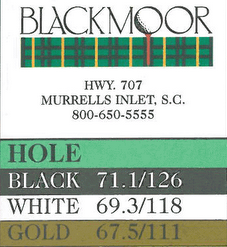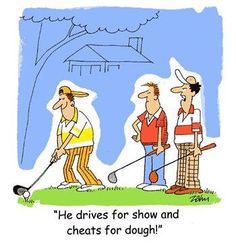One of the most recognizable golf terms that we as golfers use both on and off the course is par. Par is the number of shots that most of us golfers who are not playing on tour somewhere try to make every time that we step on a tee box of a given hole. Par is an unrealistic target score that is listed for us on every scorecard at every golf course we ever play. In the back of our minds we all know that we are not going to shoot par for an entire round of golf, but that certainly doesn’t stop us from trying to make par on every hole that we play. We know when we play a hole correctly and we don’t make any mistakes, par is the number that we’ll be recording on our scorecards.

One of the many draws to the game of golf is that it brings out a competitive spirit that lies deep within us all. We love competition whether it’s competing against one another, or simply watching others compete. In any form of competition, some of us will experience the feeling of victory while others will drown in the agony of defeat. We all love that feeling we get when we win, but that gut wrenching feeling we get when we lose also plays a big role in why we love competition. When we step on the golf course, we are able to experience both of these feelings by using what we call the handicap system.
The handicap system allows us to simply plug our scores into a computer each time that we play a round of golf and then the computer magically spits out a number that allows us to measure our ability against the ability of other golfers. This number is referred to as a “Handicap Index”. A Handicap Index can be used to compete against our friends or in a variety of tournaments. The ultimate goal of the system is to put everyone on an equal playing field prior to starting a round of golf.
The way the system works is that once we complete our round we subtract our handicap from our score to get a new score. Whoever has the lowest score after we subtract each player’s handicap from their actual score is the winner. This gives everyone the opportunity to win on a given day and at the same time rewards the player who actually had their best day on the golf course.
Almost all of us are aware of the handicap system and use it to compete against one another on courses all across the world. The only problem with this system is that it is very common that the golfers using it have no idea how their handicap is actually calculated. This is okay as the number works for competition purposes regardless of whether or not we understand where it comes from, but we always seem to have questions about the accuracy of the handicap of other golfers with whom we are competing against.
As golfers begin to question the validity of a handicap, they almost all do the same thing to determine whether the handicap is inaccurate. They all look at what par was for the course and what the player in question did in relation to par. A very common misconception about the handicap system is that a handicap is a number designed to have you shoot par for the day. This statement is believed by a vast majority of golfers and it could not be any further from the truth about how the system works.
 Golf courses are rated using a variety of different variables and then two different numbers are used based on these ratings to help us establish our handicaps. The first number is referred to as a “Course Rating” and is a rating that indicates the difficulty of a golf course for a golfer who can play a course at a handicap of zero when playing their best. The second number is referred to as the “Slope Rating” and is a number that measures the difficulty of a course for a golfer who plays to about a 20 handicap when they play their best. These two ratings are used together in a mathematical equation to come up with a golfer’s handicap.
Golf courses are rated using a variety of different variables and then two different numbers are used based on these ratings to help us establish our handicaps. The first number is referred to as a “Course Rating” and is a rating that indicates the difficulty of a golf course for a golfer who can play a course at a handicap of zero when playing their best. The second number is referred to as the “Slope Rating” and is a number that measures the difficulty of a course for a golfer who plays to about a 20 handicap when they play their best. These two ratings are used together in a mathematical equation to come up with a golfer’s handicap.
If you subtract the course rating of the tees you play from your actual score, multiply that number by the standard slope rating of 113, and then divide that by the actual slope rating of the tees you have played from you will be left with a “differential”. The differential shows us what we played to for that day. The way we arrive at our handicap index is by taking the best ten of our last twenty differentials and getting an average of these ten numbers. We then take an additional four percent away from that number. This allows us to come up with a number that reflects how we play when we play golf at our best.
It is important to note that a handicap index is not an average of how we play, but is a number that represents how we can play when we play at our best. Playing to our handicap on a given day is a challenge. We should only be able to play to our handicap about one out of every five or six times we play.
 The vast majority of golfers that huddle around to question someone’s handicap after a round is played do not look at any of the information used to actually come up with the number. They think that if par for the day is 72 (which it almost always is) and the person that they are looking at is a 10 handicap they would need to shoot 82 to have played to their handicap. Well, this is incorrect. Some courses are obviously harder than others and we all play different sets of tees that vary drastically in difficulty even though par remains the same for all of them. If a person plays from a senior tee box at roughly 5800 yards and shoots 82 and then the next day on the same golf course shoots 82 from the back tee box at 7200 yards, are those rounds are equal? Obviously, they are not even close to the same rounds of golf. We can all agree that playing the same golf course from 1,400 extra yards is harder no matter who we ask.
The vast majority of golfers that huddle around to question someone’s handicap after a round is played do not look at any of the information used to actually come up with the number. They think that if par for the day is 72 (which it almost always is) and the person that they are looking at is a 10 handicap they would need to shoot 82 to have played to their handicap. Well, this is incorrect. Some courses are obviously harder than others and we all play different sets of tees that vary drastically in difficulty even though par remains the same for all of them. If a person plays from a senior tee box at roughly 5800 yards and shoots 82 and then the next day on the same golf course shoots 82 from the back tee box at 7200 yards, are those rounds are equal? Obviously, they are not even close to the same rounds of golf. We can all agree that playing the same golf course from 1,400 extra yards is harder no matter who we ask.
We have used par as a measuring device on the course for so long that us golfers struggle to grasp the concept that it’s not used in our handicap system. I am not sure why we can’t all figure this out, or why most of us believe that par is our target score, but it’s a terrible way to try to judge whether a handicap is an accurate reflection of someone’s playing ability. Why are we so eager to use par as a target score when at no point do we use it to come up with our handicap? Using par as a measuring stick on the golf course is something that golfers have always done and feel comfortable doing regardless of the circumstances.
Using par to judge the accuracy of a handicap is something that will never work. It will never work because while par and handicap are both be golf terms, they have absolutely nothing to do with one another. Course and slope ratings are used to determine how we come up with our handicaps and these numbers must also be used to measure our success and failures after we play. Using par as a target score for handicaps will leave you with an incorrect opinion of both the person who keeps that handicap as well as the entire handicap system in general.
As we play in the future and examine our handicap, or the handicap of others, it is important to note that the target score that needs to be shot to have played to our handicap is the course rating of tee box from which you are playing. The reason the course rating is used as the target score instead of par is very simple. We use the course rating instead of par because that is what the handicap system is designed to do. We will always feel comfortable using the term par both on the course and when telling stories, but as we discuss, question, or examine handicaps, let’s just leave golf’s most recognizable term out of the conversation where it simply does not belong.





